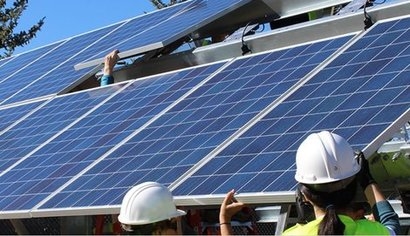
The reports were released during an event at the National Press Club introducing SEIA’s #DiversityChallenge. The challenge, issued in coordination with many of Washington’s energy trade associations, asks organisations to be active on social media by sharing their efforts to improve diversity and inclusion, sign on to the CEO Action for Diversity & Inclusion pledge, attend SEIA’s #DiversityChallenge event this week (held on Monday 6th May), and finally, mount a sustained effort to address diversity & inclusion at their company and in their industries.
The two groups have also released a diversity and inclusion best practices guide to help companies and organisations within and beyond the solar industry build diversity and inclusion programmes.
“I felt it was important to make this a public issue — to challenge others to stand up and account for the work they are doing” said Abigail Ross Hopper, SEIA’s president and CEO. “As leaders, we have a responsibility to create cultural change and address the systemic forces that have allowed discrimination to fester. We need to take account of our own actions and ask ourselves, are we doing enough? It’s imperative that we take proactive steps to advance these issues, because it isn’t going to happen on its own.”
Andrea Luecke, President and Executive Director at The Solar Foundation added that there are many exciting job opportunities in America’s growing solar industry, and these jobs should be accessible to all.
“Given the importance of the solar industry in building the energy infrastructure that is needed to confront the challenge of climate change, the solar industry has a tremendous opportunity to serve as a diversity and inclusion workforce model for the wider economy” Ms Luecke said.
The new publications update and expand on earlier reports to show where the solar industry stands on diversity and inclusion, and to offer ideas for improvement.
The US Solar Industry Diversity Study 2019 provides in-depth data on wages and career development for women and people of color in the solar industry. It is a follow up to an initial report released by The Solar Foundation in 2017.
The study, based on a statistical survey of solar employers and another survey of employees, found the industry still has more work ahead to meet its commitments to diversity and inclusion in the workforce. Some of the key findings include:
Among all senior executives reported by solar firms, 88 percent are white and 80 percent are men.
Women in solar make 74 cents on the dollar compared to men. The median wage reported for men was $29.19, while for women it was $21.62. Moreover, 52 percent of men feel they have successfully moved up the career ladder, compared to only 37 percent of women.
Solar companies tend to rely on personal or professional networks in hiring, but this may limit their ability to recruit diverse candidates. Only 28 percent of Hispanic or Latino employees found their jobs through a referral or by word of mouth, compared to 49 percent of non-Hispanic employees. Only 28 percent of black or African American employees found their job in this way, compared to 44 percent of white employees.
Just 36 percent of solar companies formally track employee demographics and diversity. However, this is an increase from the 2017 study, when only 27 percent of companies did so.
The majority of solar employees surveyed reported a positive working environment. 73 percent of respondents agreed their firm cultivates a culture of respect, equity and positive recognition of differences.
Overall, the solar industry has more work to do in order to reflect the diversity of the overall population, a challenge that is shared with the wider energy industry. The Solar Foundation’s National Solar Jobs Census 2018 found that women make up 26 percent of the solar workforce, black or African American workers comprised 8 percent, Hispanic or Latino workers represented 17 percent, and Asian workers comprised 9 percent.
“Diversity and inclusion are essential to making the solar industry as accessible as possible” said Scott Wiater, President and CEO of Standard Solar. “While the industry is working hard toward expanding into all communities, studies like this highlight where the gaps are so we can do a better job on filling them. Over time, we hope that our industry workforce will be as diverse as our world, and studies like this will help us get there.”
The Diversity Best Practices Guide for the Solar Industry offers suggestions for building and sustaining a diverse and inclusive culture, provides case studies on actions currently undertaken by leading solar organizations, and points out areas where organizations can examine their work practices and look for areas of improvement.
The Guide is organised into five key focus areas, and provides best practices and tactics for a variety of workforce-related topics, including outreach and recruitment, interviewing and hiring, retention, upward mobility, and cultural inclusivity. The Guide was developed in partnership with SEIA members and external experts in the Human Resources and diversity & inclusion field.
“A robust renewable energy economy is a critical piece of tackling the climate crisis and starts with a strong diversified workforce” said Kristen Graf, Executive Director of Women of Renewable Industries and Sustainable Energy (WRISE). “I am so thankful for the solar industry’s ongoing commitment to diversity, equity, and inclusion, but we still have a great deal of work to do to make the kind of progress we need to see and to take full advantage of the opportunities and economic potential. I look forward to engaging with individuals and companies to further this work, bringing together all of the voices and ideas required to meet the challenges that lie ahead, and I echo the call for action from my colleagues at SEIA and The Solar Foundation to the broader renewable energy community.”
For additional information:
Solar Energy Industries Association (SEIA)
Women of Renewable Industries and Sustainable Energy (WRISE)

